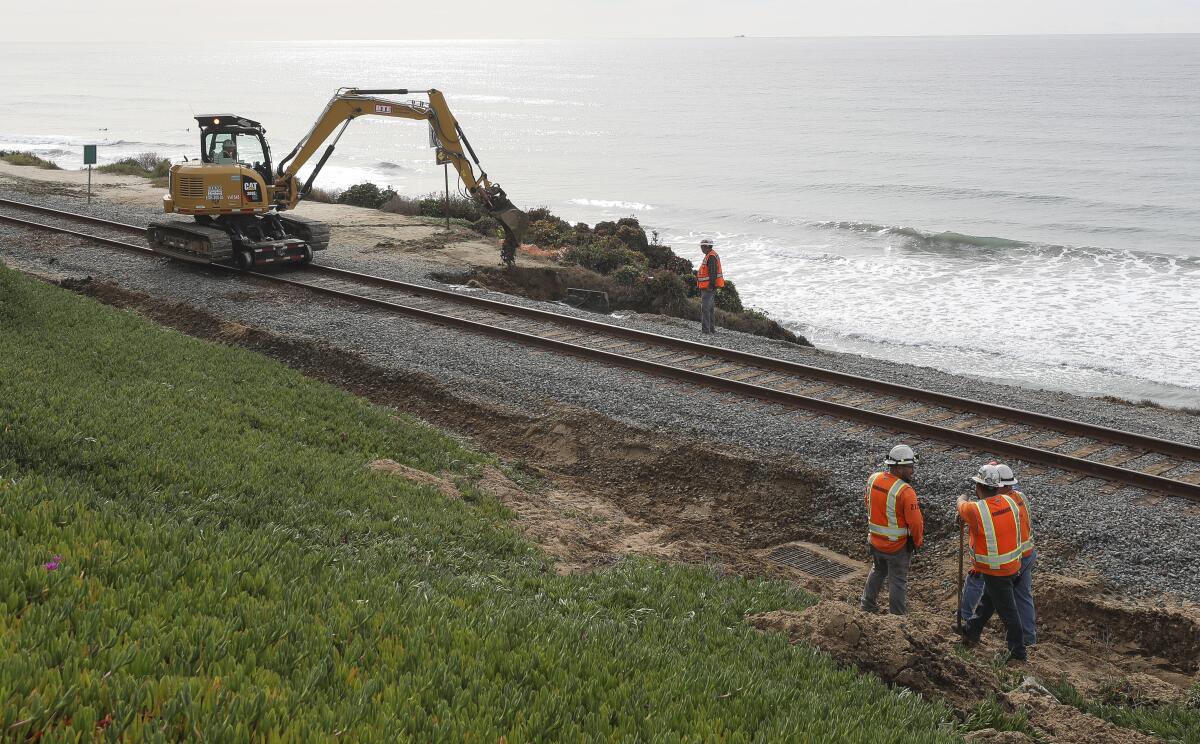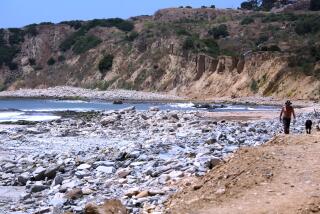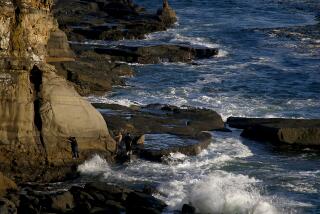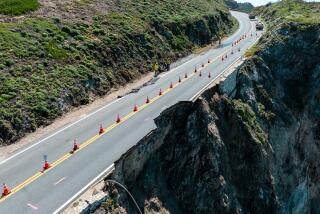Storm runoff blamed for railroad track washouts on fragile Del Mar bluff

Transit district studying options for addressing second ‘area of concern’
DEL MAR, Calif. — A second spot may need repairs after an unusually wet Thanksgiving Day storm closed the railroad tracks at Del Mar for work over the weekend, transit district officials said Monday.
The “area of concern” is less than a block away from the spot fixed Saturday, North County Transit District Executive Director Matt Tucker said Monday in an email to the district’s board of directors.
The additional job needs an engineering design plan before the work is done, and it may wait until January to be included in the next phase of the district’s ongoing bluff stabilization work, Tucker said.
“NCTD is gathering details regarding the failures and the needed repairs,” he said. “More detail will follow as we have solid facts.”
In the meantime, more rain is expected Tuesday night and Wednesday. Passenger trains are limited to no faster than 30 mph and freight trains to 10 mph through the eroded bluff-top area, Tucker told the board.
Last week’s storm brought about 2.5 inches of rain to Del Mar.
“There was a tremendous amount of run-on water from the city,” said Stephen Fordham, director of capital projects for the transit district. “It impacted some of our inlets, over-topping our inlets.”
The main washout came within about 20 inches of the railroad ties at the edge of the fragile coastal cliff.
Trains continued through the area at slow speeds on Friday, and traffic was suspended Saturday for the repair work. After a contractor completed the repairs, service resumed on Sunday.
Del Mar is doing its best to prevent stormwater from draining onto the tracks and causing more damage, a city official said Monday.
“Public Works is busy conducting post-storm inspections [and] cleanings of our storm drain system in anticipation of the next round of storm events,” said Clem Brown, environmental sustainability and special projects manager for the city.
“In addition, crews are placing sand bags at critical spots around the city to direct runoff into the storm drain system and away from public/private properties,” Brown said. “Since last week’s event, more areas around the city are being protected with sandbags.”
Most of the storm drains are on the railroad’s right-of-way, but they are fed by rainwater from the streets, parking lots and other impermeable surfaces in Del Mar. When the drains are clear, they carry rainwater under the tracks and down to the beach without eroding the cliffs.
The coastal rail corridor is the only route for Amtrak, Coaster and freight trains between Los Angeles and San Diego.
Few people realize the significant amount of railroad freight carried in San Diego County, largely because those trains usually travel at night to avoid commuter and passenger trains.
About 10% of all new foreign automobiles sold in the United States arrive on ships in San Diego and are loaded onto specially designed railroad cars that carry them up the San Diego County coast to Los Angeles and other destinations.
San Diego’s coastal rail route was established more than a century ago.
Rain runoff is one of many factors that eat away at the fragile bluffs in Del Mar. Other issues include seepage from landscape irrigation that weakens the cliffs, and the occasional high tides and big surf that eat away at their base.
“It is not uncommon for heavy rain in Del Mar to trigger collapses in unstable cliffs,” said Adam Young, a researcher at Scripps Institution of Oceanography. “However, wave erosion at the cliff base is a fundamental process that creates the cliff instability and allows the rainfall and groundwater to act more efficiently.”
NCTD has about 1.7 miles of track on the ocean bluffs between 15th Street in Del Mar and the bridge and Torrey Pines State Beach. Erosion consumes an estimated 6 inches per year, though the amount varies widely from season to season and year to year.
That makes it difficult, if not impossible, to predict when and where the next bluff collapse might occur.
“Mother Nature and water are fantastic at finding weak spots,” Fordham said, and the transit district uses “best management practices” such as clearing storm drains and monitoring erosion to protect the tracks.
Last week’s storm runoff washed out the wood lagging, a wall of timbers, that held back the soil between concrete columns, or piles, sunk deep into the earth. The area is just south of Seagrove Park, an area where the tracks are 25 to 40 feet above the beach. Farther south the cliffs are higher.
A contractor Saturday replaced the wood lagging with two steel plates, each an inch thick and 8 feet by 10 feet, Fordham said. The space behind the plates was filled with about 20 cubic yards, or two truckloads, of concrete slurry, which sets in about 45 minutes.
NCTD and the San Diego Assn. of Governments have been working for years on a series of projects to stabilize the bluffs at Del Mar.
Construction is expected to begin in January on the fourth phase of that work, a $3.1-million effort that will improve drainage structures and add more concrete and steel reinforcement columns. Previous phases of the work were completed in 2003, 2007 and 2009, according to SANDAG.
Congress approved an additional $6.1 million in June to begin planning the fifth phase of bluff stabilization work. In all, SANDAG has projected six phases of construction needed to stabilize the tracks on the cliffs until 2050.
Compounding the problems of the railroad at Del Mar is the narrow right-of-way between the ocean bluff and private homes. There’s no room to add the second set of tracks that’s being built through most of the county as part of plans to increase rail service.
Several possible routes have been studied for the eventual relocation of up to five miles of the tracks to take them around the bluffs through Del Mar. Alignments being considered would take trains up to a mile inland and through more than two miles of tunnels up to 120 feet beneath the ground.
But relocating the tracks could cost as much as $3.5 billion, according to the most recent estimates, and there’s little money or political will to accomplish that long-term goal.
Del Mar Mayor Dave Druker, after hearing an update on the repairs at Monday’s council meeting, said the concrete piles probably saved the track from falling onto the beach.
“While it is somewhat dangerous, it is safe to drive the train,” Druker said, adding that SANDAG and the city need to push for moving the train tracks off the bluff.
“We need to get the track off the bluff as quickly as possible,” he said. “The bluff is just way too vulnerable at this point.”
Diehl writes for the San Diego Union-Tribune.
More to Read
Sign up for Essential California
The most important California stories and recommendations in your inbox every morning.
You may occasionally receive promotional content from the Los Angeles Times.











